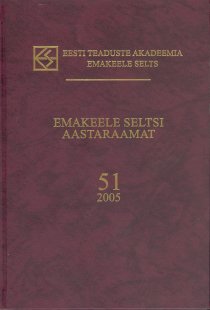Eesti keele verbikesksed püsiühendid tekstikorpuses
Estonian Multi-Word Expressions in a Text Corpus
Author(s): Kadri MuischnekSubject(s): Language and Literature Studies
Published by: Eesti Teaduste Akadeemia Kirjastus
Keywords: Phraseology; morphosyntax; statistics
Summary/Abstract: This article describes the use of Estonian multi-word expressions in a text corpus of 300,000 words. The article focuses on those multi-word expressions that consist of a verb and its complement(s) – the verb-phrase multi-word expressions. The article seeks answers to the following questions: 1) what kind of multi-word expressions are frequent in the written text, and 2) what types of variation of the nominal components of these expressions can one register in the text corpus. The multi-word expressions consisting of a verb and a noun phrase or an adpositional phrase can be classified into four subtypes: 1) opaque idiomatic expressions, 2) transparent idiomatic expressions, 3) support verb constructions, and 4) collocations. The corpus analysis shows that the nominal components of the opaque idiomatic expressions are frozen in a certain case form and number and they cannot be modified (e.g. sai aru ‘he/she understood’). The transparent idioms form a heterogenous group in this respect: some nominal components of these expressions can be used in non-default number (e.g. nemad murravad paid ‘they are racking their brains’ vs. tema murrab pead ‘he’s racking his brain’), some nominal components of the transparent idiomatic expressions occur in the cases of the total object in the corpus although the default case of the phraseological object is the partitive (e.g. sai tuule tiibadesse ‘he spread his wings’), and some of them can be modified with an attribute (e.g. klaarivad poliitilisi arveid ‘they are settling some political accounts’). The nominal components of the support verb constructions show most variation of the studied groups of multi-word expressions. These nominal components can be used in the singular as well as in the plural (e.g. tegi hüppe ‘made a jump’ vs. tegi hüppeid ‘made some jumps’), they can alternate in the cases of the object (pidas kõnet ‘he held a speech’ vs. pidas kõne), and they can be modified (e.g. pidas pika targa kõne ‘he made a long wise speech’). The article studies in detail these variations and their motivation.
Journal: Emakeele Seltsi aastaraamat
- Issue Year: 2005
- Issue No: 51
- Page Range: 080-106
- Page Count: 26
- Language: Estonian

